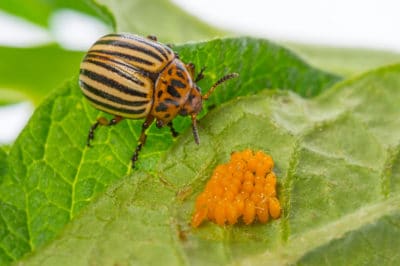Potato Bug Basics
The Colorado potato bug is an oval insect just under one-half inch in length. They are yellowish-orange and have black stripes. They are capable of flying considerable distances. Larvae start out brick red with black heads. As they age, the color changes to pink or salmon-colored with black heads. Both stages have two rows of dark spots along their sides.
Timing
Here are some facts about potato bug development and timing:
- Potato bugs usually become active about the same time potato stems and leaves appear – usually in May.
- Eggs begin to hatch within two weeks of being laid.
- Larval development is temperature-dependent and can vary from 10 to 30 days.
- In long-season areas, there may be two or three generations of potato bugs.
Don’t Wait to Take Action
Adult potato bugs overwinter in the soil. When the weather warms in spring, they emerge, make a beeline for the nearest potato plant and start eating. After a few days, they start to mate. The minute you see a potato bug in the spring, it’s time to go into action. Once the eggs are laid, you could be dealing with hundreds if not thousands of larvae.
Remove the Eggs
One of the first steps in controlling potato bug larvae is to learn how to recognize egg cases. Attached to the underside of the leaves, the eggs are a bright yellowish orange. Individual eggs are oval-shaped and the female lays them in clusters. This makes it relatively easy to decrease the numbers of larva by removing all or part of the leaf on which the eggs are located.
Control Methods
Both adult potato bugs and larvae can be hand-picked. Do so early in the morning and drop the insects into a pail of soapy water. Release or encourage lady bird beetles, which prey on the eggs. Potato bugs are resistant to commercial insecticides, which organic gardeners prefer to avoid anyway. Pyrethrin, a short-acting organic insecticide, is a possibility.
Other Strategies
It’s important to give your potatoes optimum growing conditions to prompt ideal plant health. Healthy plants can tolerate some insect pressure. Practice good garden sanitation to help decrease overwintering spots. Clean up weeds that might provide an alternate food source. Plant early-maturing varsities. Although potatoes can be grown in all USDA Zones, you might want to plant extra-early to avoid the bug season.
